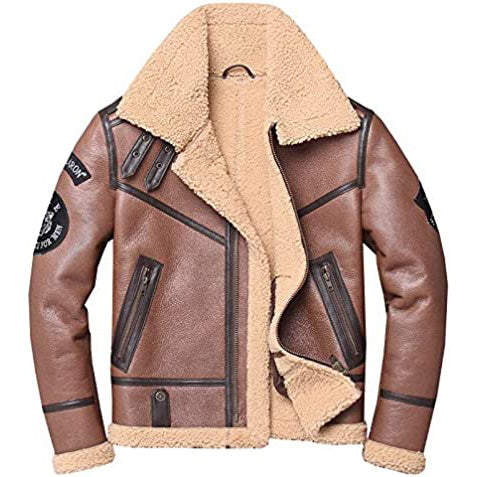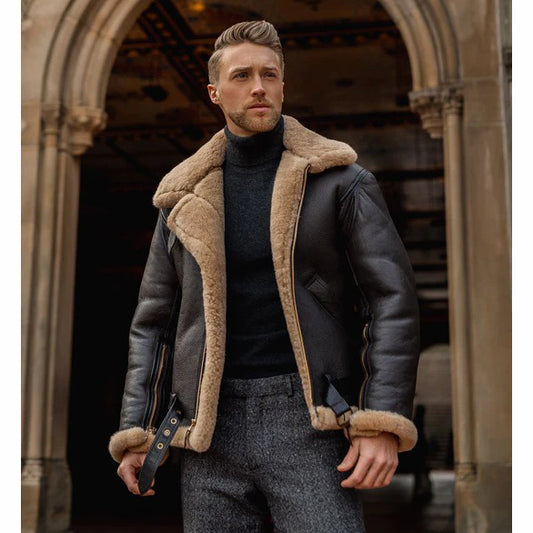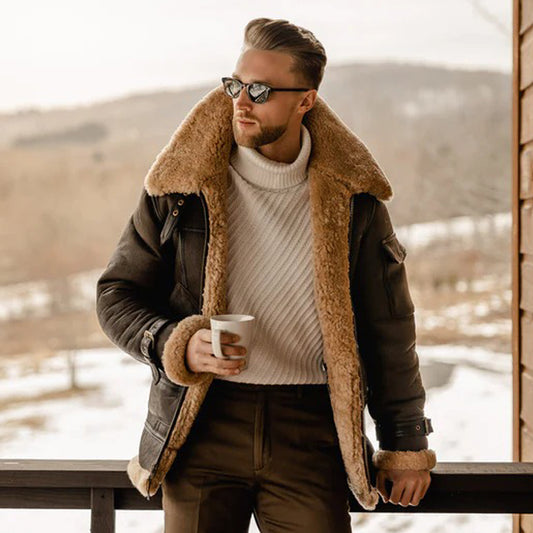Introduction: The Enduring Allure of the Men’s Peacoat
Imagine stepping out on a crisp winter morning, wrapped in a coat that exudes both history and style. The men’s peacoat is more than just outerwear—it’s a statement. For centuries, the peacoat has shielded sailors from harsh winds and inspired designers with its classic silhouette. Its journey from the decks of naval ships to city streets is a testament to its enduring appeal. Whether you’re drawn to its rugged durability or its effortless sophistication, the peacoat offers unmatched versatility. It’s a piece that tells a story—one of tradition, resilience, and timeless fashion. Discover the rich history, unique features, and modern styling tips for the men’s peacoat. Let Jackets Kingdom guide you through everything you need to know about this iconic outerwear.
1. The Origins of the Men’s Peacoat: A Naval Necessity
The men’s peacoat traces its roots back to the 18th-century European navies, particularly the British Royal Navy. Designed for sailors braving the harshest sea conditions, the peacoat was crafted from heavy, tightly woven wool to provide warmth and protection against wind and water. Its short length allowed for ease of movement on deck, while the double-breasted front and broad lapels could be buttoned up to shield the chest and neck. The term “peacoat” is believed to derive from the Dutch word “pijjekker,” referring to a coarse woolen fabric. This practical design quickly became standard issue for naval forces, setting the foundation for the peacoat’s enduring legacy. The naval peacoat origins are a testament to the blend of function and form that defines this classic garment.
2. Evolution of the Peacoat: From Sailors to Civilians
As the peacoat proved its worth at sea, it began to catch the eye of civilians. After World War I and II, surplus military clothing—including peacoats—became widely available. Men returning from service continued to wear their peacoats, introducing them to mainstream fashion. By the mid-20th century, the peacoat had evolved from a strictly utilitarian garment to a symbol of rugged masculinity and understated elegance. Designers started experimenting with cuts, colors, and materials, making the peacoat accessible to a broader audience. Today, the peacoat fashion evolution is evident in its presence on runways and city streets alike, proving that a garment born out of necessity can become a style icon.
3. Key Features That Define the Peacoat
Several distinctive features set the men’s peacoat apart from other outerwear. The double-breasted front, typically with six to eight large buttons, provides extra insulation and a sharp silhouette. Broad lapels can be turned up for added protection against the elements. The peacoat’s short, hip-length cut ensures ease of movement, while vertical or slash pockets offer both functionality and style. Traditionally made from heavy navy-blue wool, modern peacoats may feature a range of colors and fabrics. These classic men’s outerwear details not only enhance the coat’s practicality but also contribute to its timeless appeal. The combination of durability, warmth, and style makes the peacoat a perennial favorite.
4. The Peacoat in World Wars: Function Meets Fashion
During both World Wars, the peacoat became synonymous with military efficiency and resilience. Issued to naval personnel, it was designed to withstand the rigors of life at sea. The thick wool fabric provided insulation against freezing temperatures, while the double-breasted design offered extra protection. The peacoat’s practicality did not go unnoticed by civilians, who began adopting it for everyday wear. Its association with the military lent it an air of authority and respectability. The navy uniform peacoat became a symbol of service and sacrifice, further cementing its place in fashion history. Even today, the peacoat’s military heritage is evident in its design and enduring popularity.
5. Peacoat Materials: Wool, Buttons, and Beyond
The traditional peacoat materials are central to its functionality and style. Heavy melton wool, known for its density and water resistance, remains the fabric of choice for authentic peacoats. This material ensures warmth and durability, making the coat suitable for harsh weather. Large, anchor-embossed buttons—often made of metal or plastic—are another hallmark, reflecting the coat’s naval origins. Modern variations may incorporate blends of wool, cashmere, or synthetic fibers for added comfort and style. The choice of lining, stitching, and hardware can also influence the coat’s look and feel. Understanding these materials helps buyers appreciate the craftsmanship behind every peacoat, whether vintage or contemporary.
6. The Peacoat’s Rise in Popular Culture
The peacoat’s rise in popular culture is a testament to its versatility and enduring appeal. From Hollywood icons like James Dean and Steve McQueen to modern celebrities, the peacoat has been embraced by style leaders across generations. Its appearance in films, television, and music videos has cemented its status as a symbol of cool sophistication. Fashion designers frequently reinterpret the peacoat, blending classic elements with contemporary trends. The coat’s ability to transcend social and cultural boundaries makes it a favorite among men of all ages. Whether paired with jeans or tailored trousers, the peacoat remains a staple in the wardrobes of those who value both tradition and innovation.
7. Peacoat vs. Other Classic Men’s Outerwear
When comparing the peacoat vs. other coats, several distinctions emerge. Unlike the longer trench coat or the more casual bomber jacket, the peacoat strikes a balance between formality and practicality. Its double-breasted design offers more warmth than a single-breasted overcoat, while its shorter length provides greater mobility. The peacoat’s structured silhouette and classic detailing set it apart from parkas and duffle coats. For men seeking a versatile outerwear option that transitions seamlessly from work to weekend, the peacoat is an ideal choice. Its unique blend of military heritage and modern style ensures it stands out in any collection of iconic men’s jackets.
8. How to Style a Peacoat for Modern Men
Styling a men’s peacoat is all about versatility. For a classic look, pair it with a turtleneck sweater, slim-fit jeans, and leather boots. For business settings, layer the peacoat over a suit or dress shirt and trousers. The coat’s neutral colors—navy, black, or gray—make it easy to coordinate with various outfits. Accessories like scarves, gloves, and beanies can add both warmth and personality. The peacoat’s structured shape flatters most body types, making it a reliable choice for men of all ages. Whether dressing up or down, the peacoat offers endless possibilities for expressing personal style while staying warm and comfortable.
9. Caring for Your Peacoat: Maintenance Tips
Proper care is essential to preserve the quality and appearance of your peacoat. Always follow the manufacturer’s cleaning instructions, as most wool peacoats require dry cleaning. To maintain the coat’s shape, hang it on a sturdy, wide-shouldered hanger. Brush the fabric regularly to remove dust and lint, and spot-clean stains promptly with a damp cloth. Store your peacoat in a cool, dry place during the off-season, using a garment bag to protect it from moths and moisture. With the right care, a well-made peacoat can last for decades, retaining its warmth, structure, and timeless appeal. These peacoat care tips ensure your investment remains in top condition.
10. Why the Peacoat Remains a Timeless Wardrobe Staple
The enduring popularity of the men’s peacoat lies in its unique combination of history, functionality, and style. Its origins in naval tradition lend it a sense of authenticity and ruggedness, while its clean lines and classic silhouette make it a versatile addition to any wardrobe. The peacoat’s ability to adapt to changing fashion trends without losing its core identity is a testament to its timelessness. Whether worn by sailors, soldiers, or style icons, the peacoat continues to symbolize confidence, resilience, and sophistication. For those seeking a coat that offers both practicality and elegance, the peacoat remains an unbeatable choice.
Frequently Asked Questions
1. What is the origin of the men’s peacoat?
The peacoat originated in 18th-century European navies, designed to protect sailors from harsh sea conditions.
2. What materials are used in a traditional peacoat?
Traditional peacoats are made from heavy melton wool, with large anchor-embossed buttons and sturdy stitching.
3. How should a peacoat fit?
A peacoat should fit snugly at the shoulders, with enough room to layer underneath, and end at the hips for ease of movement.
4. Can a peacoat be worn in formal settings?
Yes, the peacoat’s structured design makes it suitable for both casual and formal occasions.
5. How do I care for my peacoat?
Most wool peacoats require dry cleaning. Store on a wide hanger, brush regularly, and protect from moths during storage.
6. What makes the peacoat different from other coats?
The peacoat’s double-breasted front, broad lapels, and naval heritage set it apart from other classic men’s outerwear.
7. Is the peacoat still in style today?
Absolutely. The peacoat remains a staple in men’s fashion, valued for its versatility and timeless appeal.
8. Are there modern variations of the peacoat?
Yes, designers offer peacoats in various colors, fabrics, and cuts to suit contemporary tastes.
9. Can women wear peacoats?
While traditionally a men’s garment, peacoats are now popular in women’s fashion as well.
10. Where can I buy a quality peacoat?
Jackets Kingdom offers a curated selection of high-quality peacoats, blending classic craftsmanship with modern style.
Discover Your Next Peacoat at Jackets Kingdom
Ready to add a timeless classic to your wardrobe? Explore the latest collection of men’s peacoats at Jackets Kingdom. Experience the perfect blend of history, style, and durability—crafted for the modern man. Shop now and embrace the legacy of the iconic peacoat.




